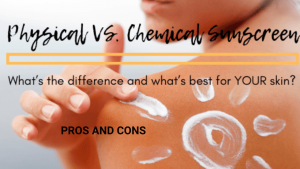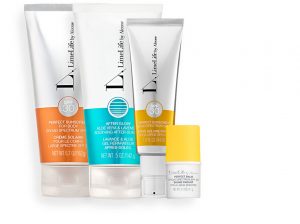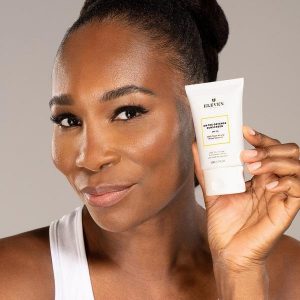
Sunscreens – Physical (Mineral) vs Chemical: Pros and Cons
All skin needs daily sun protection to keep it healthy and youthful. But, which type of sunscreen should you choose and which works best? Sun protection generally falls into one of two categories: chemical and physical (mineral). While both provide protection, chemical sunscreen and physical sunscreen differ in their active ingredients as well as the way they protect against UV exposure. Read on to learn the difference, and discover the benefits of using a mineral sunscreen.
How Sunscreen Works
A sunscreen is a compound (or lotion) that uses agents to block, deflect or reflect the sun’s harmful ultraviolet (UV) rays.
For maximum efficiency, it’s recommended that all sunscreens be liberally applied (at least an ounce for the entire body and ¼ – ½ oz on your face) to all areas that are directly exposed to sunlight.
Which SPF NUMBER Is the Best To Use
First of all, let’s learn about the right SPF number and what you should be using.
Higher numbers on labels are more about marketing. In fact the FDA is proposing to ban sunscreens that are labeled with an SPF number higher than 50. There is no scientific evidence showing that they offer any more protection than sunscreens with lower SPF ratings. The suggested recommendation is a minimum of an SPF of 30 and a maximum of 50.
Physical (Mineral) Sunscreens
“Mineral sunscreens are made with ingredients that include zinc oxide and titanium dioxide. In general, mineral or physical sunscreens tend to rate better than chemical sunscreens. Zinc oxide and titanium dioxide are generally recognized as safe and effective, have 0 to less than 0.01% of skin penetration, and have no evidence of hormone disruption” according to EWG 2020 Guide to Sunscreens.
These minerals form a protective barrier on top of the skin to deflect and scatter damaging UV rays away from the skin. They are often referred to as physical blockers.
My favorite mineral sunscreens are from LimeLife by Alcone and they carry a full Sun Set Collection which includes Perfect Sunscreen for Face, Perfect Sunscreen for Body, After Glow and Perfect Balm Sunscreen for Lips.

What Is Zinc Oxide?
Mineral sunscreens typically use zinc oxide as a physical blocker of UV rays. Yes, the same zinc that people slathered over their nose and cheeks in the seventies and eighties. Zinc oxide has come a long way since then, and can now be found in lightweight, layerable formulas that provide the same sun protection but with a natural-looking finish.
Pros of Physical Sunscreen:
- Keeps The Skin Cool
- Zinc oxide keeps the skin cool and allows it to breathe. It reflects the heat and energy of the sun’s rays away from the skin. For this reason, mineral sunscreen is particularly beneficial in minimizing skin inflammation and redness associated with acne, rosacea and skin sensitivity.
- Provides Mineral Sun Protection
- Zinc itself is a natural substance and can be found in nature. In addition to being a physical blocker, zinc oxide acts as a mirror to reflect UV rays before they can penetrate the skin’s surface
- Suitable For All Skin Types
- Mineral sunscreens are hypoallergenic and non-comedogenic. With their anti-inflammatory properties, they are gentle enough for the most sensitive skin types. They are free of pore-clogging silicones, making them a better option for those prone to blemishes.
- Mineral sunscreens are less likely to cause a stinging irritation on the skin, making it better for sensitive skin. Better for those with heat-activated skin (such as rosacea and redness) since it deflects the heat and energy given off by the sun away from the skin; and they are safe for use on babies and during pregnancy.
Cons of Physical Sunscreens:
- Can rub off, sweat off and rinse off easily, meaning more frequent re-application when outdoors as needed.
- May leave a white-ish cast on the skin, making some formulas incompatible for medium to dark skin tones.
- New up to date information, if you are darker skinned, try EleVen by Venus Williams Sunscreen “Safe for our planet and perfect for people of all skin shades and types. We hope to inspire all to get outside, be active and stay healthy!” Credo Beauty

Chemical Sunscreens
Chemical Sunscreens are often referred to as chemical absorbers. Through a chemical reaction, the chemical compounds convert UV rays into heat, then release that heat from the skin.
“In recent FDA testing, all non-mineral sunscreen chemicals are absorbed into the body and could be measured in blood after just a single use; many sunscreen ingredients have been detected in breast milk and urine samples.” EWG 2020 Guide to Sunscreens.
Commonly Used Ingredients in a Chemical Sunscreen
- Avobenzone: This is the most commonly used UVA chemical filter found in chemical sunscreens. This ingredient causes relatively high rates of skin allergy.
- Octinoxate: This chemical filter is absorbed rapidly into the skin and has moderate rates of skin allergy. It has hormone-like activity; affects the reproductive system, thyroid and behavioral alterations.
- Octisalate: While Octisalate helps absorb UVB rays (but not UVA rays), it’s also a penetration enhancer, meaning it increases the amount of other ingredients that pass into your skin. If a chemical sunscreen contains hazardous ingredients, they are more likely to pass into the body when Octisalate is present in the formula.
- Oxybenzone: This chemical UV filter absorbs UVB and UVA rays, but it is a photosensitizer. It has relatively high rates of skin allergy.
- Octocrylene: This chemical UV filter can absorb both UVB and UVA rays. It has relatively high rates of skin allergy.
Pros of Chemical Sunscreens:
- Thinner and spreads on the skin like a lotion, making it ideal for daily use.
- Less product is needed to protect the skin.
- Easier to use with other products like peptides and enzymes, giving you skincare boost in a single product.
Cons of Chemical Sunscreens:
- Can possibly cause an increase in existing brown spots and discoloration due to a higher internal skin temperature (overheated skin can make brown spots worse, such as melasma).
- Requires about 20 minutes after application before it starts to work.
- Increased chance of irritation and stinging due to the multiple ingredients combined in order to achieve broad spectrum UVA and UVB protection.
- The higher the SPF (such as formulas of SPF 50 or greater), the higher the risk of irritation for sensitive skin types.
- The protection it offers gets used up more quickly when in direct UV light, so re-application must be more frequent.
- Increased chance of redness for rosacea-prone skin types because it changes UV rays into heat which can exacerbate flushing.
- Chemical sunscreens may be more likely to clog pores, which can make breakouts more frequent for those with oily skin.
- The ingredients found in chemical sunscreens can irritate the eyes.
Which sunscreen is right for you?
According to Penn Medicine Abramson Cancer Center, “Those with sensitive skin or young children may opt for a physical sunscreen since those ingredients are milder.
Both types of sunscreen provide adequate protection, however your personal preference may help you decide what type of sunscreen is right for you. The most important thing to remember is to choose a sunscreen you will use.”
